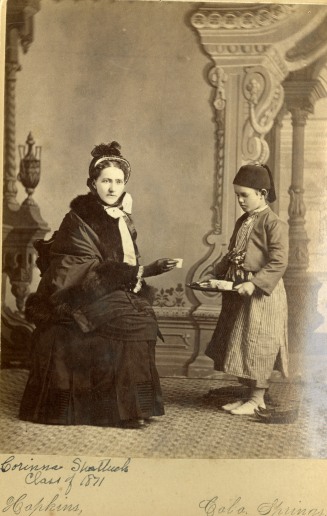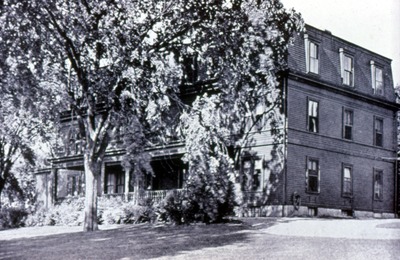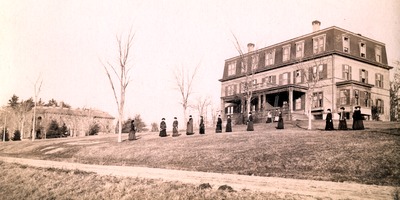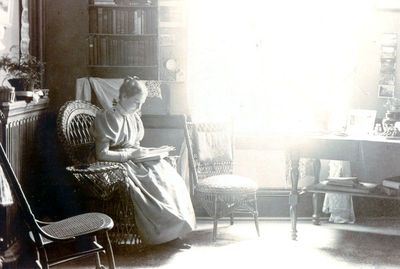
Corinna Shattuck was a young girl when she was orphaned. Born on April 21, 1848 in Louisville, Kentucky, Shattuck lost her father at the age of one and her mother three years later. Before her death, Shattuck’s mother moved her family consisting of a young Corinna and three more siblings to Acton, Massachusetts, her home town. The four children lived with their maternal grandparents in Acton after the loss of their mother. Shattuck’s grandparents instilled a deep religious faith which she carried with her for the rest of her life. This mixed with a strong desire to help those less fortunate than her lead her to missionary work.
Shattuck’s time at Framingham Normal School is characterized by her correspondence with Framingham alum Myra Proctor. Proctor was working as a missionary in Aintab, Turkey at the time. She had opened a school and was more than happy to write to Shattuck about her life and her mission work. Proctor became Shattuck’s inspiration. Shattuck set her sights on Turkey and after her graduation from the advanced program in 1873 that’s exactly where she went. She arrived there on August 27, 1873. In her first few years in Turkey she spent her time learning the language, adapting to the culture, and riding horseback for over one thousand miles to see the country. Shattuck had persistent health problems that sent her back to the United States in 1879 for several years. Unfortunately, she was prone to tuberculosis which limited her ability to breathe; she essentially had one functioning lung. By 1883 she resumed her work in Turkey.
Shattuck’s time in Turkey is known for several major accomplishments. In her time teaching she encountered one student, Mary Harootoonya who lost her sight. Shattuck worked to get Harootoonya into the Royal Normal College for the Blind located in London. After her return to Turkey, Harootoonya and Shattuck teamed up to build the Corinna Shattuck School for the Blind.
Shattuck had been placed in multiple locations across Turkey, and in 1892 she requested to be moved from Marash to Oorfa (present day Urfa). Her request was granted and she was moved to her new city. It was her influence in Urfa that made Shattuck particularly well known. Tensions had been on the rise in Turkey between different religious groups, particularly the Muslims and Christians. In October of 1895 Christians were confined by soldiers to a section of the city and forced to give up any weapons they may have owned. For a couple of months they were allowed to go about their daily lives. Shattuck sensing trouble requested the Turkish government for a permit to leave the city for her safety. Her permit was granted on December 28th, 1895, one hour before the Oorfa Massacre.
The Muslims and Kurds in combination with the soldiers raided the Christian section of Urfa. They attacked any Christian man they found, leaving the women and children alone unless they tried to protect their fathers and husbands. Their houses were ransacked and everything of value was stolen, even the front doors. Soldiers were posted outside of Shattuck’s door to keep the trouble out, but her neighbors jumped her fences and crowded her home. For fear of the government discovering how many people she was hiding, Shattuck moved the men to a nearby Protestant church to hide until the attack was over, and she provided sanctuary to their wives and children.
By the end of it all the death toll was in the thousands. A Georgian church was set on fire with three thousand people trapped inside. The soldiers inspected Shattuck’s home for any fugitives, and satisfied in not finding any men they departed without any trouble. That night Corinna Shattuck saved the lives of over three hundred people.
After the massacre there were hundreds of orphans and widows. Shattuck’s heart broke for the orphans, especially as someone who was orphaned herself. Seeing the rising desperation around her Shattuck got to work. She adopted over 150 orphans and started several new institutions. She began by teaching the young girls and the widows how to sew and embroider. Shattuck found a wholesale company in Ireland that helped her sell the products her girls were making, and the business became a surprising success. The extra profit allowed her to expand her operations to include three homes for the children. The boys were in charge of the vineyards, making shoes, and in their off time the local tradesmen taught them carpentry, tailoring, and the like. To her credit, Shattuck allowed all ethnic groups to her homes. This helped ease some of the religious tensions and eliminate some prejudice amongst the children. At its height, her operation employed over two thousand people.
All of this success built a reputation for Shattuck. She became known for settling disputes and facing government officials with a cool head. In an interesting turn of events, an Arab man named Ibrahim Pasha sent his horsemen to attack Shattuck’s farms. Angry at the men for trying to hurt her students she took to a horse herself and rode to Pasha’s settlement. There she waited until he finally opened his tent for her. What was said when she officially met with him is unknown, but by the time she rode back to Urfa Pasha had sworn his eternal protection for her farms. After this incident she was used as a mediator for any other disputes that occurred near Urfa.
Shattuck dedicated over thirty years of her life to her work in Turkey. By 1910 her sickness was overwhelming her and she left Turkey to seek treatment back in the US. She made it to Massachusetts General Hospital in Boston and from there she was sent to Cullis Consumptives’ Home. She lived out her final days in the Cullis Home where she died on May 22, 1910 at the age of 62. Shattuck’s impact on the lives on her students in Turkey is undeniable. In a time of terror, she sheltered them. In a time of turmoil, she gave them food and a home. When raiders appeared in the hills she sent them flying away. Here is a woman who should make us proud to be a part Framingham.
Photo Courtesy of Independent Association of Framingham State Alumni
Written by,
2017 English Intern
Ryan Toomey






